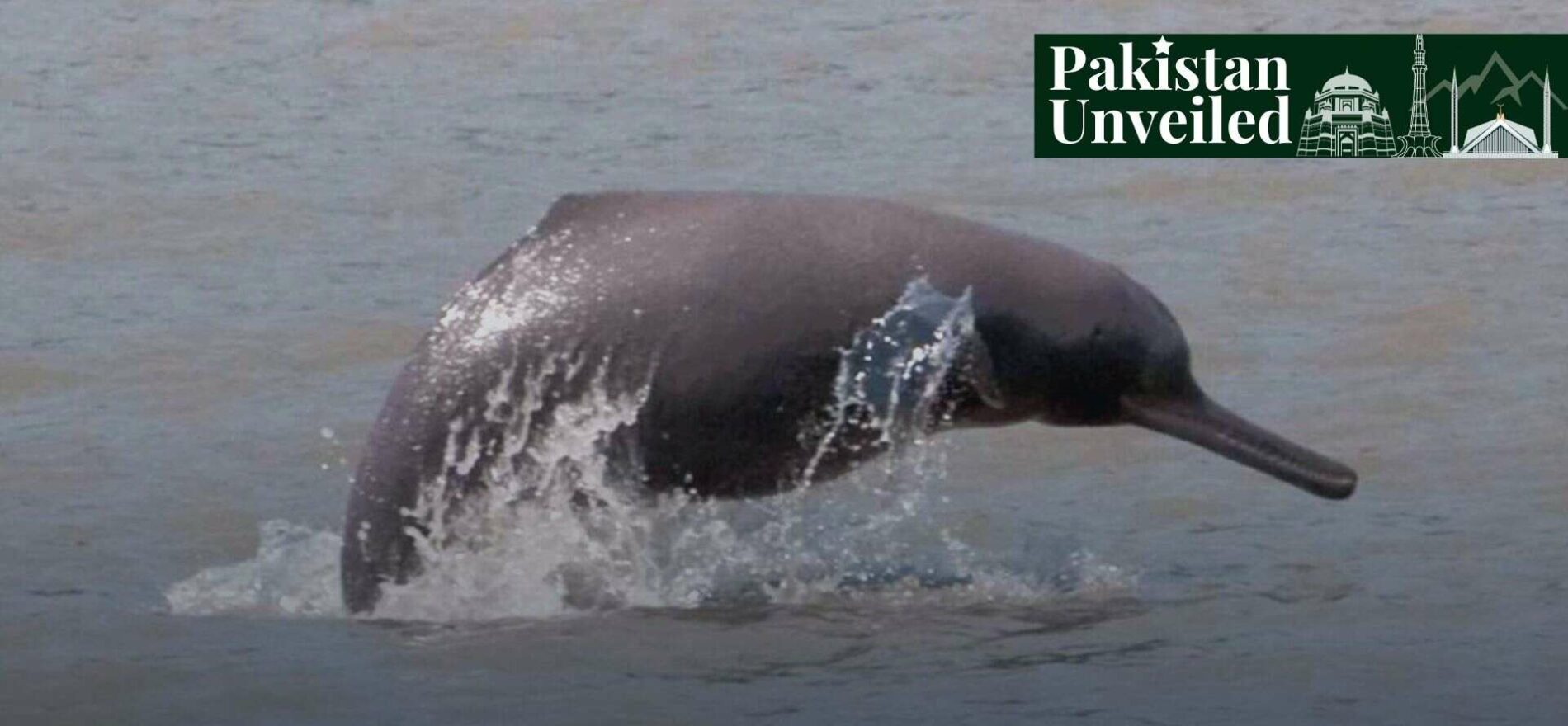Ms. Amina Iqbal is studying international relations at Kinnaird College for Women University, Lahore.
Introduction
The Indus River dolphin is a widely recognized symbol of environmental health and cultural legacy. It is also known as “bhulan” and is found in abundance in the tranquil waters of the great Indus River in Pakistan. The Indus River dolphins are exceptional creatures due to their sleek bodies, and their dependence on echolocation and acrobatic displays. However, this freshwater cetacean is a tribute to the river’s rich ecological tapestry and has evolved over the ages to navigate these primitive water currents. Hence, WWF played an important role in safeguarding the Indus River dolphins, and there’s still hope that these endangered species will be preserved for future generations.
Characteristics and Behavior of the Indus River Dolphin
The Indus River dolphins (Platanista minor) are often confused with the Ganges River dolphins (Platanista gangetica). However, they’re different species, but their similarities are due to the fact that they belong to the same subspecies. Bhulans have sleek and smooth bodies but they lack the distinctive dorsal fins of a sea dolphin. They have compressed eyes and a layer of skin that covers them, which makes them unusual in their adaptation to the muddy river environment. One can say that they’re functionally blind.
Moreover, they can easily maneuver through the intricate river systems with the help of their flexible necks and long, thin snouts. These dolphins are well known for providing acrobatic performances in the sea, you can often see them diving and twirling. The blind river dolphin relies less on its vision as compared to its marine counterparts, and that is why it uses echolocation to navigate, communicate and to find food.
Life Cycle & Diet
Indus River dolphins usually attain sexual maturity at the age of 10. On the other hand, mating takes place all year round with a peak period ranging from March and May. A single calf, approximately 70 cm in length, is born and fed on breast milk after an 8-9 month gestation period. The maximum length of these calves is 2.5 meters, and their weight range lies between 70 and 110 kg. Additionally, the lifespan of the oldest known individual was 39 years, despite the lack of information regarding their lifetime. They have a diverse food range, ranging from carp, catfish, and river prawns, as well as other animals that are present in their natural habitat.

Habitat Challenges Faced by Indus River Dolphins in Pakistan
In Pakistan, Indus River dolphins are able to swim freely over a distance of around 3,500 km from the Karakoram mountains to the Indus Delta but their habitat has been severely reduced due to the installation of irrigation barrages, resulting in a nearly 80% reduction in the area they inhabit. Nowadays, a 690 km stretch of the Indus River basin serves as a home to three distinct groups of dolphins. However, in subsidiary channels and small tributaries, these dolphins are less prevalent since they favor the deep river channels.
From October to April, dams and barrages restrict a large portion of the river’s flow as it is considered the low water season. Therefore, it causes habitat destruction for dolphins downstream of the Sukkur Barrage and in many lower parts of the Indus. As a result, in winter, the water level drops so dolphins gather in the remaining deep areas.
Conservation Status of the Dolphin Population
The Indus River dolphin is still listed as “endangered” on the International Union for Conservation of Nature’s (IUCN) red list and under the US’ Endangered Species Act as well. The species has earned its place on the IUCN red list of threatened species since at one point, the population of the dolphins fell to less than one thousand. Since the dolphins are vulnerable and unable to swim back upstream, conservation interventions are necessary.

According to the statistics in 2017, there are almost 2,000 Indus River dolphins worldwide. The second most endangered mammal in the world, can be found in the Sindh province between the Guddu and Sukkur barrages at the highest concentrations, while there are also minor populations in other provinces such as Punjab and KPK.
However, since the 1970s, the regular dolphin count has increased. The reason behind this increase is the prohibition on hunting of river dolphin species and other successful conservation efforts. The Sindh Wildlife Department has played a crucial role in preserving the dolphins found in Pakistan. Hence, it has been thought that the dolphin population has been going through a recovery period as hunting has been stopped in the current times.
Cultural Significance of the Endangered Indus River Dolphins
Locally, Indus River dolphins have great cultural significance and are often seen as a representation of the historic Harappan civilization. For centuries, dolphins have been found in the Indus, which highlights a deep historical connection. Despite all of this, some fishermen still viewed Indus River dolphins as rivals for fish, posing threats to their livelihoods. Although hunting has been banned since the 1970s, accidental deaths in fishing nets continue to be a problem, showcasing the continuous struggle to strike a balance between local economic needs and conservation initiatives.
Environmental Threats
Environmental threats have been faced by the Indus River dolphins, mainly stemming from water-related infrastructure like dams, barrages, and diversions that disrupt the natural flow of parts of the Indus River. This results in the fragmentation of the Indus River dolphins’ habitats. Additionally, these constructions reduce the quantity as well as the quality of the water, impeding the passage of migratory fish, which is crucial to the dolphin’s diet. If the dolphins are not rescued, they may accidentally die from entanglement in fishing nets or by being stuck in irrigation systems.
The contamination from domestic, industrial, and agricultural sources poses major threats to the dolphins’ health as they are susceptible to pollutants such as heavy metals and industrial waste. Thus, Indus River dolphins are highly valued in their culture and are considered an indicator of the health of the river. Still, their preservation is threatened by these environmental pressures.
Conservation Efforts by WWF
WWF played a pivotal role in conserving the Indus River dolphins. Their projects for preserving them include rescuing stranded dolphins and combating wildlife crimes. WWF promotes sustainable fishing techniques and enhances public understanding of the ecological significance of dolphins via educational programs and seminars.
Moreover, WWF also focuses on creating better agricultural management practices to minimize water pollution and safeguard biodiversity. Through close collaboration with fishing communities, WWF offers different opportunities to diversify income sources, lessen the strain on natural resources, and promote a more sustainable coexistence among communities and the Indus River dolphin’s distinctive habitat.
Community-led Initiatives
Local communities play a vital role in preserving these species, and without their support, it would not be possible to protect them. As a result, WWF collaborates with the local communities that live along the stretches of the Indus River dolphin to create new livelihoods, reforest the river bank, and utilize fewer chemicals associated with the leather industry. In addition, these local communities are crucial for the safe release of Indus River dolphins that become stuck in irrigation canals. Thus, WWF raised public awareness regarding the safeguarding of these species in educational centers and by conducting different outreach programs in schools.
Conclusion
Conclusively, Indus River dolphins are a significant symbol of the river’s ecological balance and Pakistan’s cultural heritage, highlighting a link to the state’s rich historical tapestry. Despite facing multiple threats ranging from habitat fragmentation brought on by water-related infrastructure to contamination from various pollutants, organized conservation efforts led by different organizations, such as WWF, have demonstrated faith in preserving these amazing dolphins.
Furthermore, initiatives to alleviate the difficulties experienced by the Indus River dolphins have been put into practice through a combination of rescue operations, community engagement, and lobbying for sustainable practices, but the road to preservation is still ongoing and ultimately requires constant cooperation and commitment from all parties involved.
If you want to submit your articles and/or research papers, please check the Submissions page.
The views and opinions expressed in this article/paper are the author’s own and do not necessarily reflect the editorial position of Paradigm Shift.



















